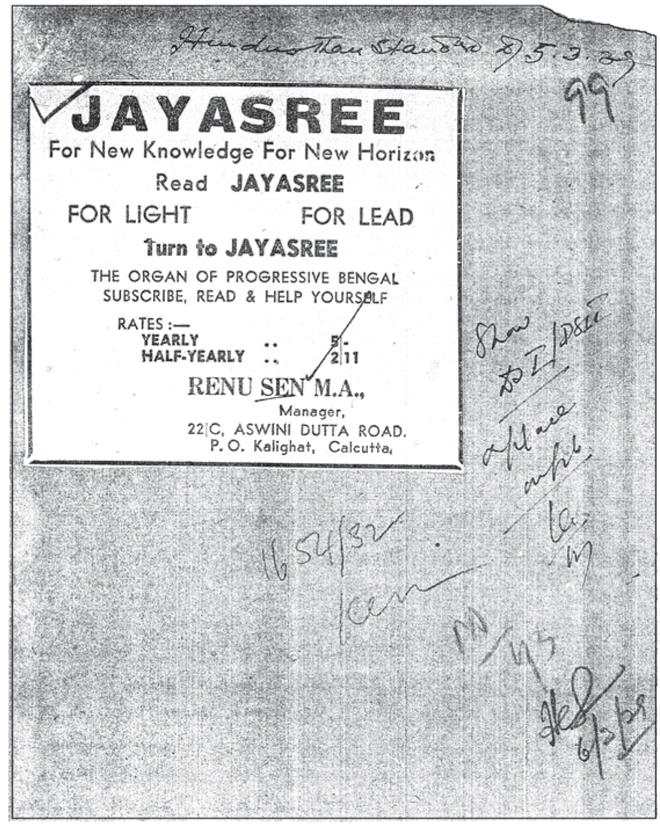
The first files on women revolutionaries in Bengal appeared in the Intelligence Branch of British India roughly around 1919. And by 1947, more than 200 cases of conviction and sentencing of women were recorded in these files.
Along with these convictions and sentences, the files of the Intelligence Branch of Bengal had a long list of women revolutionaries or suspects – approximately 900. Along with the files, the West Bengal State Archives also has history-sheets on revolutionaries and thousands of glass and film negatives that record details of their surveillance. All such interesting details about women revolutionaries are contained in a recent publication titled Women in the War of Freedom Unveiled, Bengal 1919-1947: Glimpse from Archival records.
Madhurima Sen, the author of the book, brings to the fore several interesting facts about the Indian freedom struggle from the functioning of the British Intelligence Branch in Bengal, which kept surveillance on the revolutionaries by maintaining a ‘blue list’ and a ‘red list’. The book also highlights the role of certain periodicals, particularly journals brought by women, and custody details of the women revolutionaries.
Ms. Sen, an archivist at West Bengal State Archives, has also derived information from its photo archives wing to which many did not have access. The Directorate of State Archives, West Bengal, which is one of the biggest repositories of documents from the colonial period in this part of the country, has a collection of about 50,000 glass and film negatives, including photographic print, all of which are related to ‘revolutionary activities’ in the 20th century.
“Most women mentioned in the IB files came from Hindu upper and middle classes, who could emerge from seclusion and develop a life within and outside their families and identify themselves with social and political causes. We, however, find names of Halima Khatun and Razia Khatun from Mymensingh district, Jobeda Khatun and Jayanab Rahim who were connected with the revolutionary/nationalist organisations of their time,” the publication says referring to socio- political situation of the pre-Independent India, particularly Bengal.
Ms. Sen said the trend of women’s region-wise participation in the revolutionary movement suggest that “conviction of women in the eastern part of Bengal was far greater than the western part”. The highest numbers of accused were from Chittagong,” the book said, adding that the numbers might have increased after the Chittagong Armoury Raid (1930).
In the western part of Bengal, the publication says that women revolutionaries were active in Kolkata and adjoining areas of 24 Parganas (North and South), Howrah, Hooghly, Bankura and Midnapore . “Women’s wings became active among the students of colleges in Kolkata. Bethune College had become a centre of radical feminist agitation,” she said.
The publication draws attention to certain journals of the pre-Independent period which played a crucial role in mobilising women for ‘revolutionary activities’. One particular mention is to Jayasree, a journal published by women whose title page dating February 1939 is contained in the book.
While the publication has brought several little-known facts about women revolutionaries to light, there are a number of aspects that require more study and research. Ms. Sen refers to one such revolutionary, Sudhangshubala Sircar, whose name is mentioned in the famous Alipore Bomb Case ( 1908). The publication has a four-page ‘history sheet’ on her prepared in 1909 by the Intelligence Branch. “Despite being of such importance, there are no references to her after 1908-09 and we are looking for more material on her,” Ms. Sen said. She also pointed out that in a number of cases, there are photographs but no supportive information on the women.
From Dukhoribala Devi, the first woman to be convicted for revolutionary activities, to Lila Nag, the first woman to be recruited as a member of a revolutionary organisation (Dacca Shree Sangha) in 1924, the publication also has a detailed transcription of the statement of Bina Das , arrested for her attempt on the life of Governor Stanley Jackson. Along with the names of well-known women revolutionaries – Kalpana Dutta, Bina Das, Pritilata Wadder/Waddedar, Santi and Suniti – the publication contains names of several little-known women revolutionaries who made “unforgettable contributions to the growth of militant nationalism in India”.







